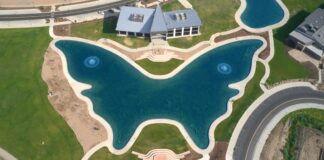$2-billion Uranium Processing Plant Will Fuel Enrichment of Eastern Idaho’s Economy
Project Title: AREVA Chooses Idaho Falls for Eagle Rock Plant
Entered By: Grow Idaho Falls and Bonneville County, ID
Project Impact Estimates:
• Direct jobs, 1,500; indirect jobs, 442; induced jobs, 632; Total jobs created, 2574
• Cost of building estimate, $800 million; cost of machinery and equipment, $1.2 billion; total cost estimate, $2 billion
• Total labor income estimate, $1,493,727,113; plant payroll (year 1), $27,000,000; total labor income (year 1), $48,000,712
• Direct output, $3,510,232,728; indirect output, $930,393,121; induced output, $696,978,867; total output, $5,137,604,716
Our 2008 Bronze Award winner provides proof positive that successful large-scale economic development is not limited to industrial states with large populations. This year’s Bronze Award goes to a joint entry from Grow Idaho Falls Inc. and Bonneville County, ID, for AREVA Inc.’s choice of Idaho Falls as the location for a new $2-billion uranium enrichment plant.
Construction of the new enrichment facility, called Eagle Rock, which will begin after a three-year design phase, is expected to employ more than 1,000 people. Once operational, the plant will employ up to 300. The AREVA project is expected to generate more than $1 billion in income/wages for the region; overall, it is expected to spur more than $5 billion in economic activity in Idaho.
Idaho Falls’ proximity to the Idaho National Engineering Laboratory (INL) and its established reputation as a nuclear-energy friendly community gave it a leg up in the competition for the AREVA facility.
“While we had several attractive sites to choose from, we opted for Idaho Falls, which has strong ties to nuclear energy and which welcomed AREVA and its proposed enrichment facility to become a new member of the community,” says Michael McMurphy, president of AREVA. “We look forward to a long-term partnership that will deliver diversity and strength to the regional economy.”
AREVA was impressed by Idaho’s regional approach to the bidding process. Three members of the Eastern Idaho Economic Development Partnership presented a “regional proposal”—including multiple sites in Idaho—to AREVA at a meeting in Boise at the state Department of Commerce.
The company also was attracted by the state’s commitment to the development of the nuclear power industry. In his announcement of the AREVA site selection in May, Governor C.L. “Butch” Otter cited Idaho’s positioning as a state with a “critical understanding” of the needs of the nuclear power industry.
“Eastern Idaho has the workforce, the infrastructure, the commitment to advancing nuclear technology, and the critical understanding of this industry. It’s a great match that will result in secure jobs and a stronger economy,” Otter said.
The governor noted that the state’s decision to provide funding for the Center for Advanced Energy Studies at INL also had enhanced Idaho’s stature as a leader in nuclear energy.
In order to win the AREVA project, the state Department of Commerce and Grow Idaho Falls worked together to create a “multi-attribute utility model” (MAUA) to satisfy 39 physical, environmental, geographical and economic criteria established by AREVA for the enrichment facility location. While more than 200 locations in numerous states were initially considered for the project, the MAUA enabled Idaho to join a list of finalists that included 10 sites in six states. Virginia, Ohio, Texas, New Mexico, and Washington were the other finalists.
In the second phase of the bidding process, economic criteria and public support for the project were given more weight by AREVA. Grow Idaho Falls, the Greater Idaho Falls Chamber of Commerce, the Partnership for Science & Technology, the City of Idaho Falls, and the Regional Development Alliance joined forces to draft legislation to accommodate necessary tax incentives. One tax hurdle that needed to be overcome was the fact that AREVA did not qualify for a sales tax exemption on its production equipment because it was defined as a “processor” and not a manufacturer (i.e. they do not own the uranium they process). Also, the states competing with Idaho offered property tax exemptions of between 80% and 100%.
The Idaho Legislature passed two bills earlier this year designed to make Idaho competitive with other states by minimizing or eliminating the tax consequences for the AREVA enrichment plant.
“We were able to show that bringing this type of large, taxpaying, for-profit business to Idaho would benefit the entire state, particularly in light of recent declining state revenues,” says Linda Martin, executive director of Grow Idaho Falls.
In May 2007, AREVA appeared before the Nuclear Regulatory Commission (NRC) to put forth its plans to site a multi-billion dollar uranium enrichment facility in the U.S. within the next 18 years. AREVA told the NRC that the facility would provide a new domestic source for enriched uranium, currently being imported to the U.S. that is used to create fuel for the 104 nuclear power plants now operating in the United States. Idaho put itself front-and-center as a contender for the AREVA plant when, early in 2008, 17 mayors and city officials from the state testified at a hearing for the Global Nuclear Energy Partnership Program. Idaho’s Congressional delegation then met with AREVA.
“We could not have done this without help from many individuals throughout our community, the state, and [from] our Congressional leadership,” notes Idaho Falls Mayor Jared Fuhriman.













![[VIDEO] Get More for Your Business in Ardmore. Oklahoma](https://businessfacilities.com/wp-content/uploads/2024/02/maxresdefault-324x160.jpg)
